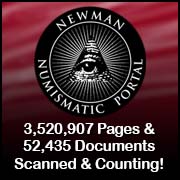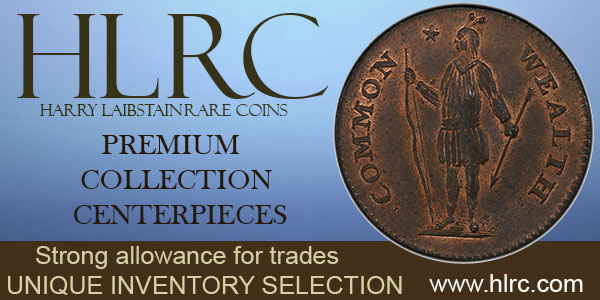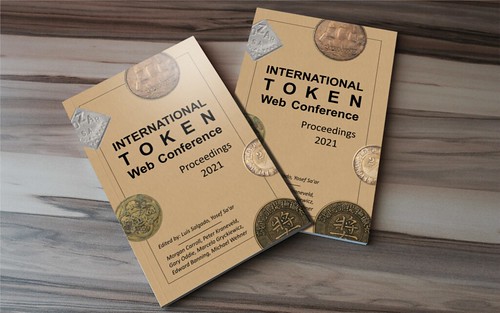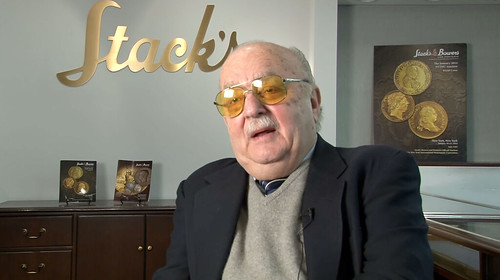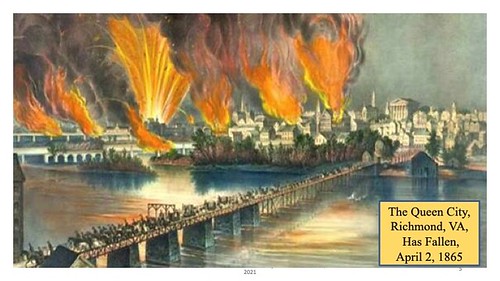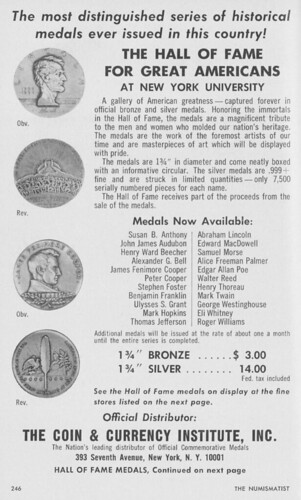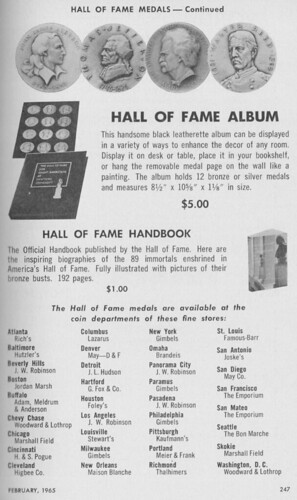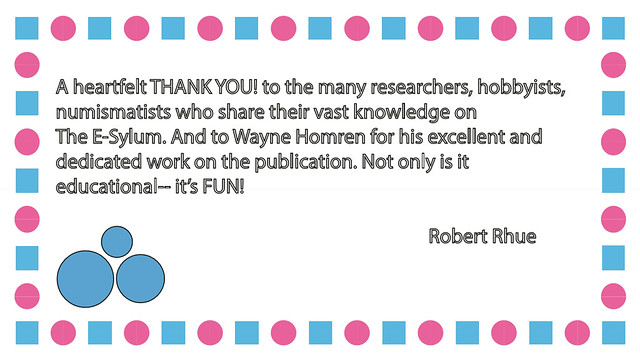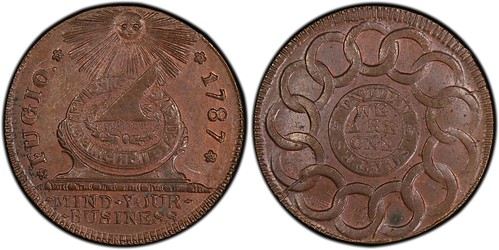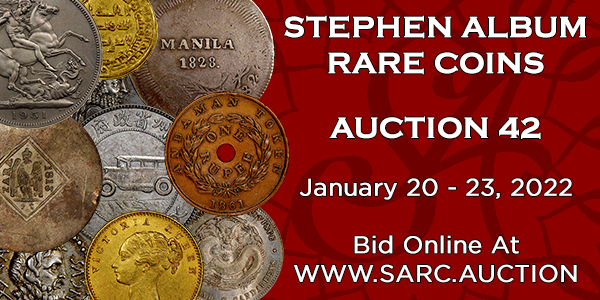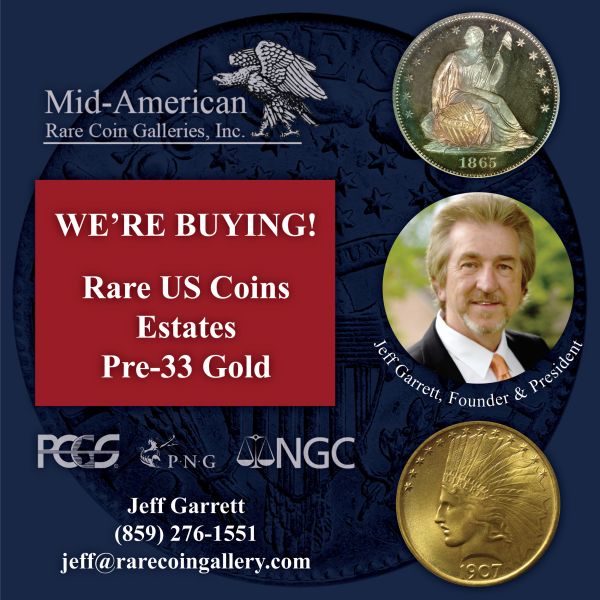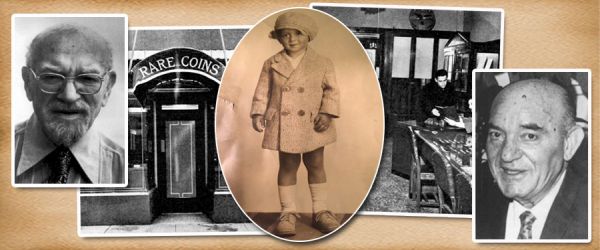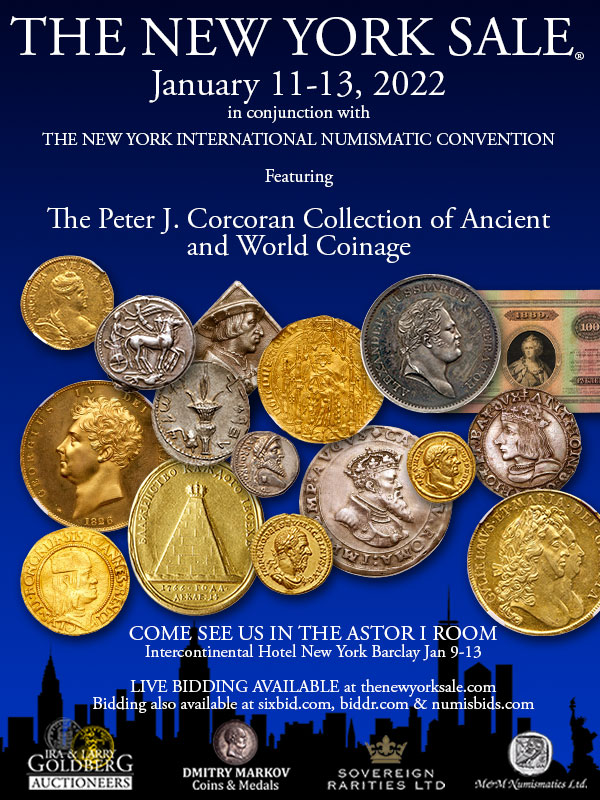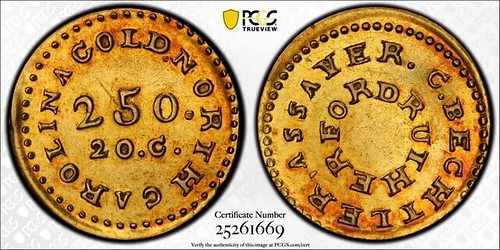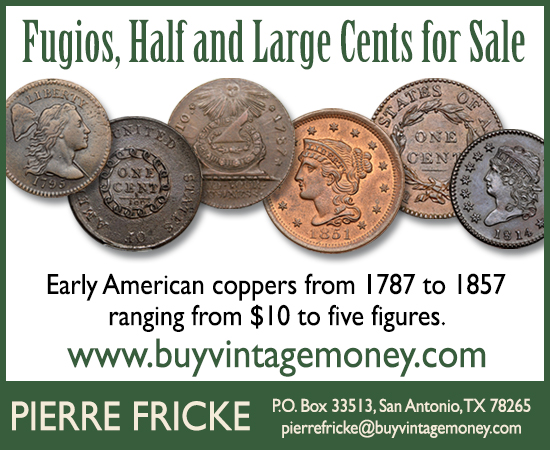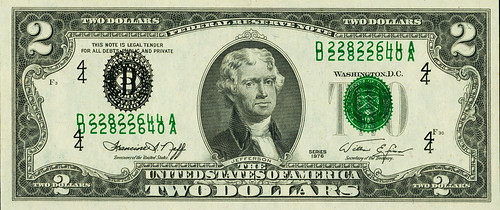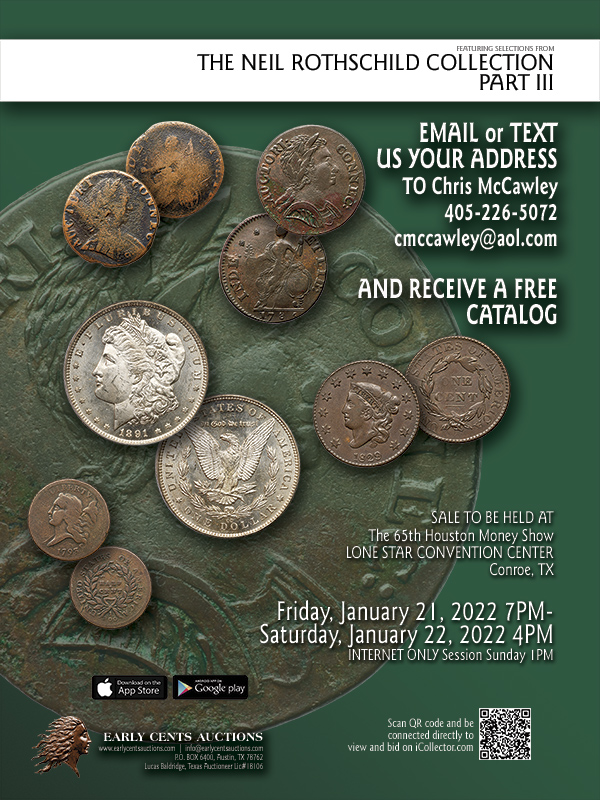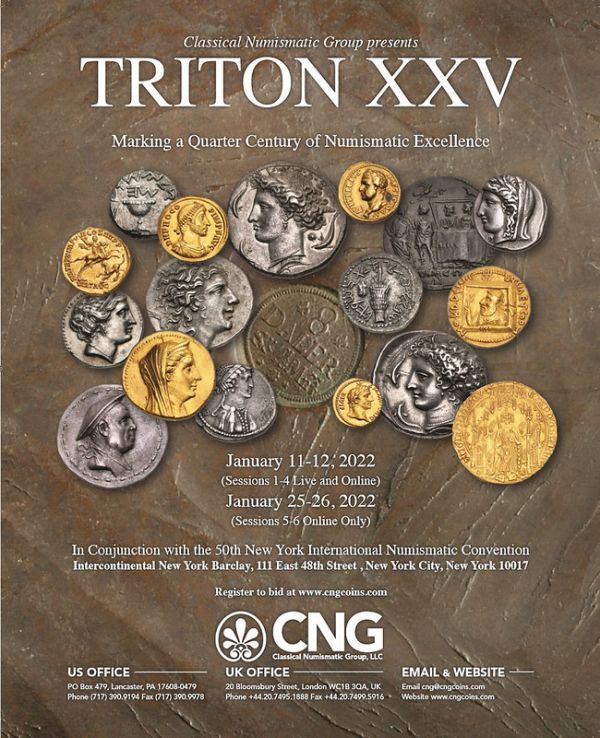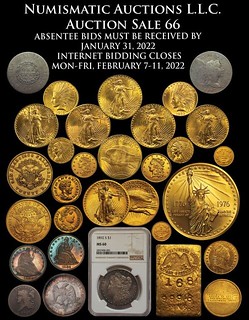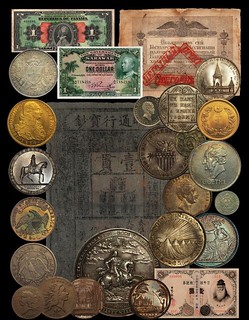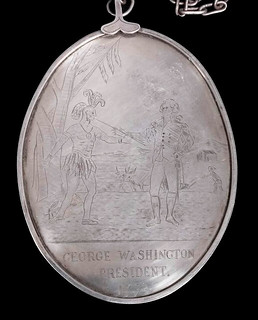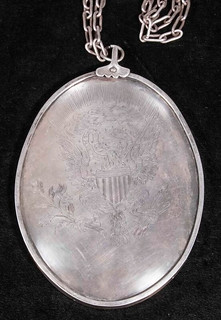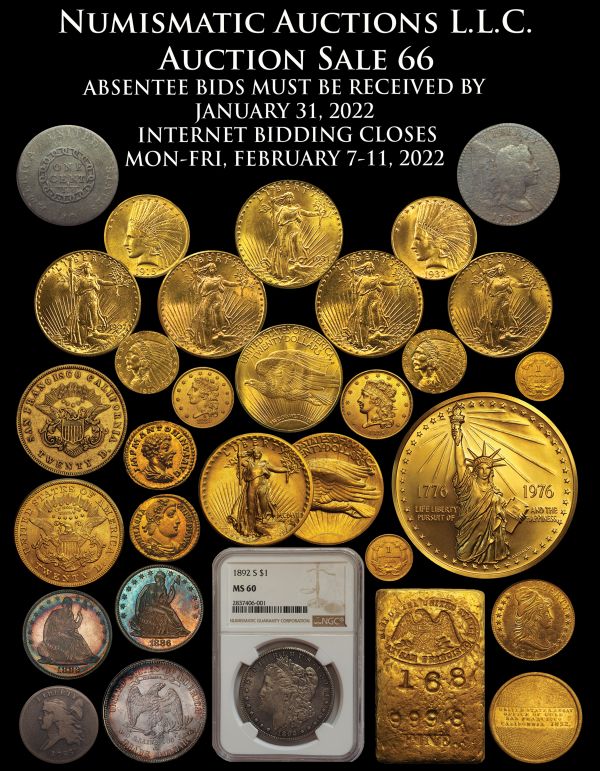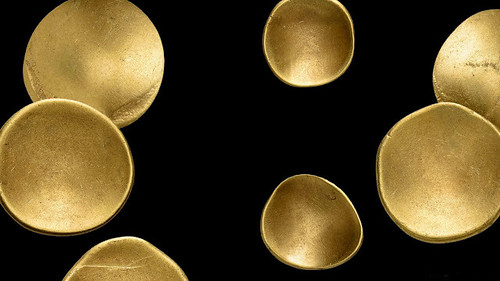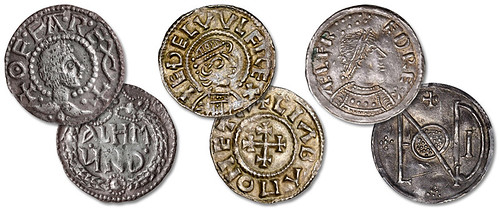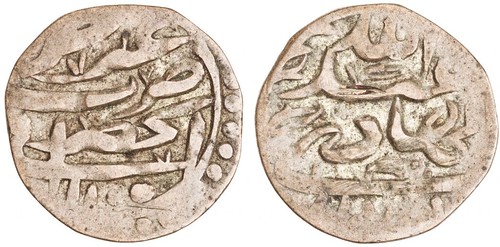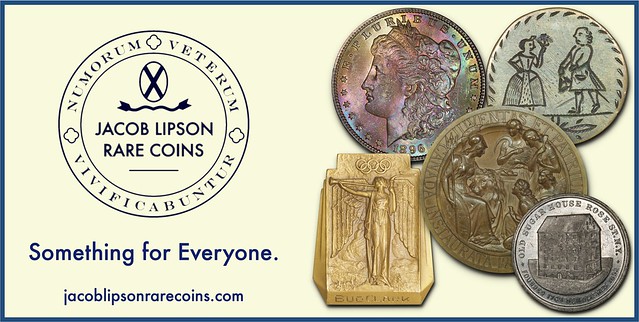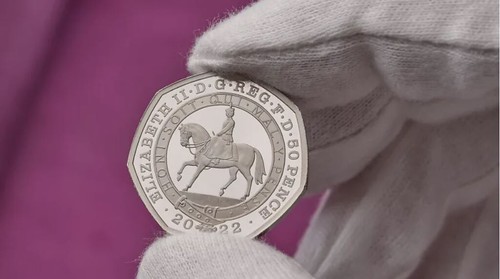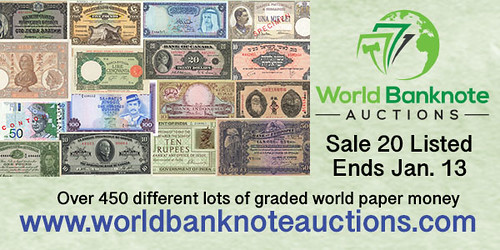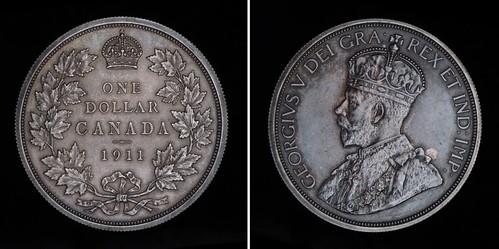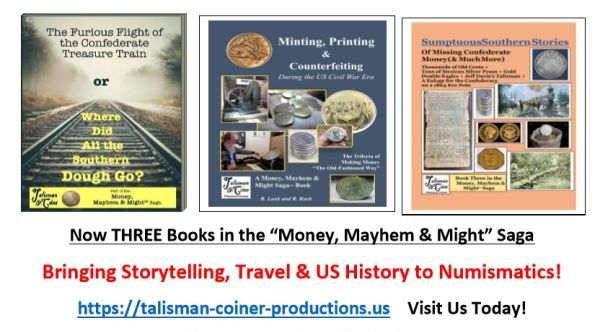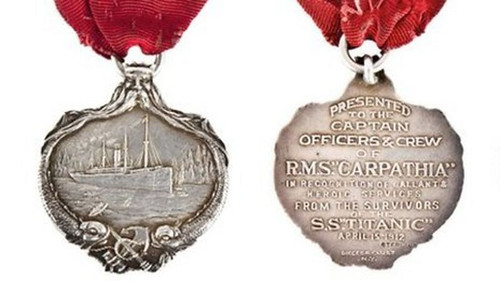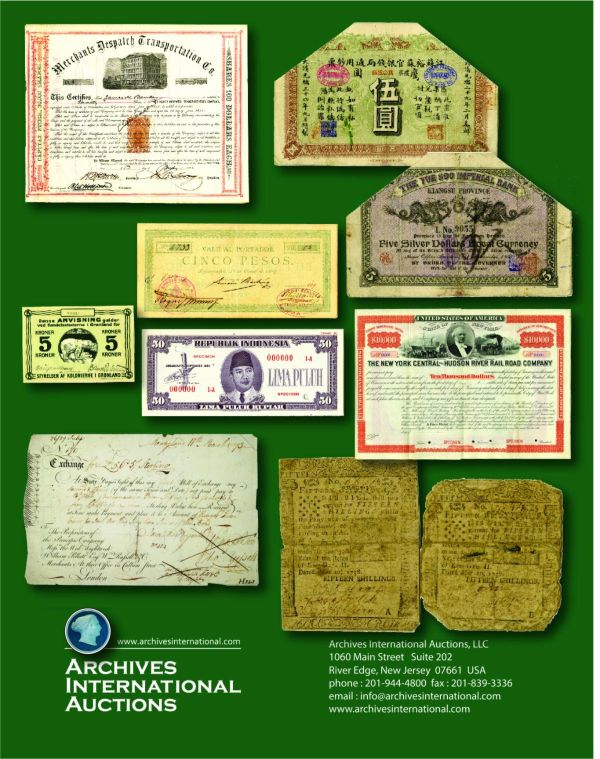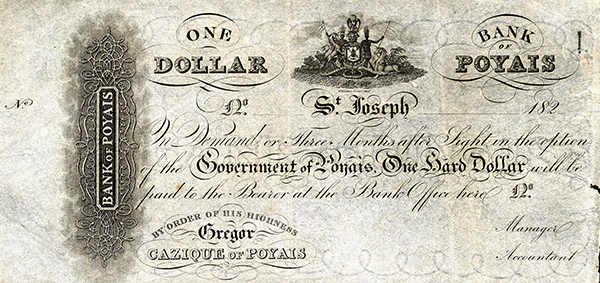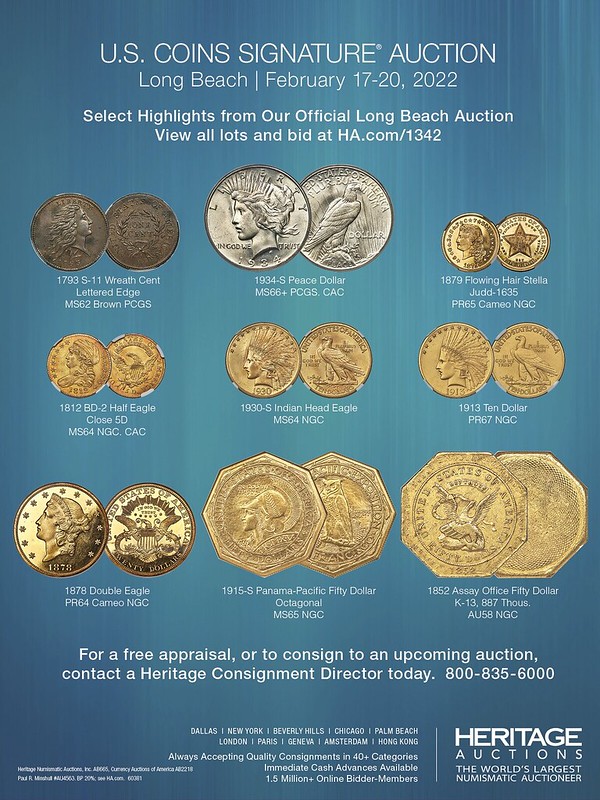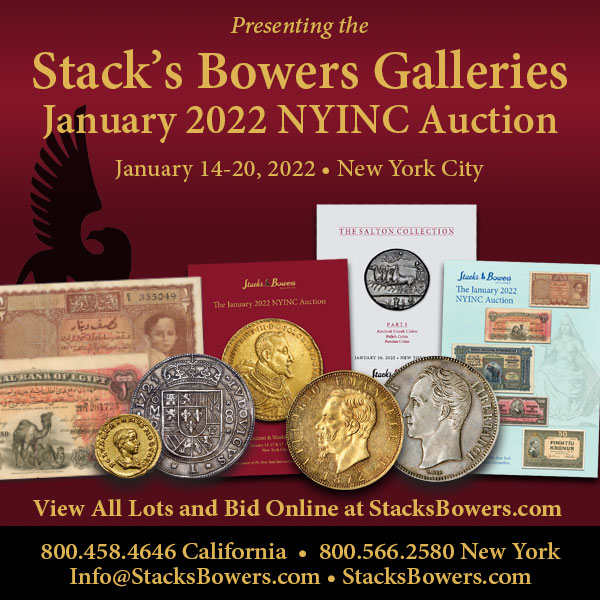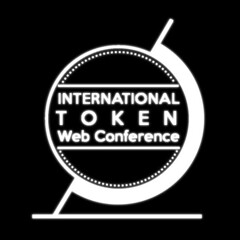
Visit our NBS Sponsors


About UsThe Numismatic Bibliomania Society is a non-profit association devoted to the study and enjoyment of numismatic literature. For more information please see our web site at coinbooks.org SubscriptionsThose wishing to become new E-Sylum subscribers (or wishing to Unsubscribe) can go to the following web page link MembershipThere is a membership application available on the web site Membership Application To join, print the application and return it with your check to the address printed on the application. Print/Digital membership is $40 to addresses in the U.S., and $60 elsewhere. A digital-only membership is available for $25. For those without web access, write to: Charles Heck, Treasurer AsylumFor Asylum mailing address changes and other membership questions, contact Chuck at this email address: treasurer@coinbooks.org SubmissionsTo submit items for publication in The E-Sylum, write to the Editor at this address: whomren@gmail.com BUY THE BOOK BEFORE THE COINSale CalendarWatch here for updates! |
- WAYNE'S WORDS: THE E-SYLUM JANUARY 9, 2022
- KOLBE & FANNING AUCTION SALE 162 ANNOUNCED
- NEW BOOK: INTERNATIONAL TOKEN CONFERENCE
- HARVEY G. STACK (1928-2022)
- ANS EARLY MEMBER CORRESPONDENCE DIGITIZED
- VIDEO: THE CONFEDERATE TREASURE TRAIN
- MORE ON ROBERT FRIEDBERG
- NOTES FROM E-SYLUM READERS: JANUARY 9, 2022
- WAR OF 1812 IN AMERICAN AND BRITISH MEDALS
- 2022 NATIONAL MONEY SHOW EXHIBITS
- PCGS RECLASSIFIES FUGIOS AS REGULAR U.S. ISSUES
- VOCABULARY TERM: HALLMARKS AND HALLMARKING
- HARVEY STACK AND STACK'S BOWERS GALLERIES
- RESEARCHING THE NEW YORK NUMISMATIC SOCIETY
- A BEVY OF BECHTLERS
- HERITAGE FUN CURRENCY AUCTION ERRORS
- STEPHEN ALBUM RARE COINS AUCTION 42
- NUMISMATIC AUCTIONS LLC SALE 66
- STACK'S BOWERS TO SELL SYD MARTIN COLLECTION
- NUMISMATIC NUGGETS: JANUARY 9, 2022
- CELTIC GOLD COINS DISCOVERED IN BRANDENBURG
- RUNZE COLLECTION HAMMERED ENGLISH PENNIES
- A CORRECTION TO
TREASURE (RHODE) ISLAND
- QUEEN'S PLATINUM JUBILEE COINS UNVEILED
- BANK OF CANADA MUSEUM ACQUIRES 1911 DOLLAR
- VERNON MEDAL INSPIRES HISTORIAN'S BOOK
- DUKE OF WELLINGTON AFGHANISTAN GOLD MEDALS
- CHARLESTON SLAVE BADGE TOP FIND OF 2021
- RMS CARPATHIA MEDAL
- POYAIS: GREGOR MACGREGOR'S FAKE COUNTRY
- PENNY PILE PRECIPITATES PROSECUTION
- LOOSE CHANGE: JANUARY 9, 2022
- FEATURED WEB SITE: INTERNATIONAL TOKEN WEB CONFERENCE
Click here to read the thin version on the web
Click here to subscribe
Click here to access the complete archive
To comment or submit articles, reply to whomren@gmail.com
Content presented in The E-Sylum is not necessarily researched or independently fact-checked, and views expressed do not necessarily represent those of the Numismatic Bibliomania Society.
WAYNE'S WORDS: THE E-SYLUM JANUARY 9, 2022
 New subscribers this week include:
Nigel Whiting, courtesy Jim Bulmer; and
Kevin Lipton, courtesy of Tony Terranova;
Welcome aboard! We now have 6,744 subscribers.
New subscribers this week include:
Nigel Whiting, courtesy Jim Bulmer; and
Kevin Lipton, courtesy of Tony Terranova;
Welcome aboard! We now have 6,744 subscribers.
Thank you for reading The E-Sylum. If you enjoy it, please send me the email addresses of friends you think may enjoy it as well and I'll send them a subscription. Contact me at whomren@gmail.com anytime regarding your subscription, or questions, comments or suggestions about our content.
This week we open with a new numismatic literature sale, one new book, and the loss of a hobby giant.
Other topics this week include the American Numismatic Society and New York Numismatic Society, Robert Friedberg, Syd Martin, Harvey Stack, War of 1812 medals, Fugio Cents, hallmarks, Bechtler gold coins, paper money errors, auction previews, hammered English pennies, the Canadian 1911 dollar, Admiral Vernon medals, and the International Token Web Conference.
To learn more about Augustin Dupré's rare 1790 Observations, the inaugural meeting of the ANS, the Confederate Treasure Train, the Hall of Fame For Great Americans, the Manley Washington medals, Fred Lincoln, and Andaman Islands penal colony, the Montefiore Hebrew Prize medal, Celtic gold rainbow cups, Her Majesty's Platinum Jubilee, Gregor MacGregor's fake country, and the Larkan Tokens of Umzimkulu, South Africa, read on. Have a great week, everyone!
Wayne Homren
Editor, The E-Sylum
KOLBE & FANNING AUCTION SALE 162 ANNOUNCED
Kolbe & Fanning have announced their upcoming numismatic literature sale. Great material in many subject areas. -Editor
January 22 Book Auction
Kolbe & Fanning Numismatic Booksellers are announcing our Sale 162, which will be held on Saturday, January 22, 2022. The 438-lot sale features material from more than two dozen consignors, and encompasses numismatic literature from around the world.
Some highlights of the sale include:
NEW BOOK: INTERNATIONAL TOKEN CONFERENCE
Yosef Sa'ar passed along information about the Proceedings for the 2021 edition of the International Token Web Conference. Thank you. -Editor
About the Book
Proceedings from the 2nd edition of the International Token Web Conference, including the following lectures:
-
The Larkan Tokens of Umzimkulu, South Africa
- Morgan Carroll; -
The Community Coinage of Griqualand
- Morgan Carroll; -
Swedish Amusement Tokens
- Peter Kraneveld; -
Farm Checks of the Fens
- Gary Oddie; -
Shearing Tokens and Cans
- Marcelo Gryckiewicz; -
Fraudulent 19th-Century Tokens From Montreal
- Edward Banning; -
San Francisco, California Gold Rush Era Tokens
- Michael Wehner; -
What Is A Token
- Peter Kraneveld et al.
HARVEY G. STACK (1928-2022)
Stack's Bowers Galleries published this press release January 5, 2022 on the passing of Harvey G. Stack. -Editor
It is with great sadness we announce the passing of our friend and founder, Harvey G. Stack on January 3, 2022. His leadership over the years spearheaded our operations and his kindness and mentorship to staff, collectors, dealers, numismatic organizations and colleagues will never be forgotten.
Harvey was born in Manhattan on June 3, 1928, the son of Morton M. Stack and Muriel Stack. He grew up in Bronx and Jamaica, New York and attended NYU. His life revolved around his family and around numismatics, as generations of the Stack family built upon the rare coin business founded in 1933 by Harvey's father, Morton, and his uncle Joseph at 690 Sixth Avenue in Manhattan. Presenting their first public auction in 1935, Stack's quickly progressed to larger premises and a growing reputation. Although as a youngster Harvey worked after school and during vacations at the firm's Manhattan coin store, it wasn't until 1947 that he went to work full time for Stack's Rare Coins, a career that would last more than 70 years. As one of the second generation of family members to join the firm, Harvey worked alongside his father, uncle, and cousins Norman and Benjamin, supported by a staff of experts that comprised many of the most well-known professional numismatists of the 20th century.
ANS EARLY MEMBER CORRESPONDENCE DIGITIZED
The latest addition to the Newman Numismatic Portal is a group of early ANS member correspondence. Project Coordinator Len Augsburger provided the following report. -Editor
American Numismatic Society Early Member Correspondence Digitized
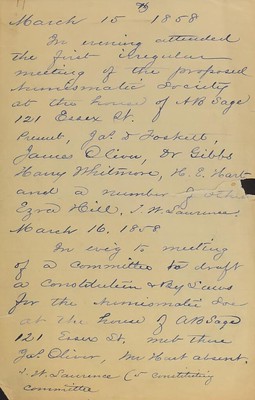 Early member correspondence of the American Numismatic Society, covering the years 1858-1899, has recently been digitized under sponsorship of Newman Numismatic Portal. In the 1858 file we see notes related to the inaugural meeting of the ANS that occurred on March 15, 1858, at the home of Augustus B. Sage, 121 Essex Place in New York City. Attending were James D. Foskett, James Oliver, Dr. Gibbs, Harry Whitmore, H. E. Hart,
Early member correspondence of the American Numismatic Society, covering the years 1858-1899, has recently been digitized under sponsorship of Newman Numismatic Portal. In the 1858 file we see notes related to the inaugural meeting of the ANS that occurred on March 15, 1858, at the home of Augustus B. Sage, 121 Essex Place in New York City. Attending were James D. Foskett, James Oliver, Dr. Gibbs, Harry Whitmore, H. E. Hart, and a number of others,
including Ezra Hill and J. W. Laurence. The tone of the first meeting must have been enthusiastic, for the next evening a smaller group met again, to begin drafting a constitution and bylaws.
Image: Notes related to the inaugural ANS meetings, March 15-16, 1858
Link to ANS early member correspondence on Newman Portal:
https://nnp.wustl.edu/library/archivedetail/515008
VIDEO: THE CONFEDERATE TREASURE TRAIN
These are selections from the David Lisot Video Library that feature news and personalities from the world of coin collecting. David has been attending coin conventions since 1972 and began videotaping in 1985. The Newman Numismatic Portal now lists all David's videos on their website at:
https://nnp.wustl.edu/library/multimediadetail/522852
Here's one on the Confederate Treasure Train. -Editor
Furious Flight of the Confederate Treasure Train, Where Did All the Southern Dough Go?
Presenters: Rick Lank & Rebecca Rush, Talisman & Coiner Productions,
Video Production, David Lisot, CoinTelevision.com.
When it was clear the South was going to lose the Civil War the Confederate Treasury and the Richmond Banks dispatched trains with the remaining money of the South thru Danville, Charlotte, Abbeville, Augusta and more. Learn about this frantic flight and the gold, silver, paper money and bonds that were spirited away and what happened to all that Southern Dough! Told by authors and storytellers Rick Lank and Rebecca Rush.
MORE ON ROBERT FRIEDBERG
Regarding the medal mentioned in Pete Smith's bio of his father Robert Friedberg, Arthur Friedberg writes:
"I know of none engraved. I still have about a dozen of them, all blank. From the story I remember at that young age, Menconi came to them offering to do a medal (quite certainly not for free, but I have no idea of the terms).
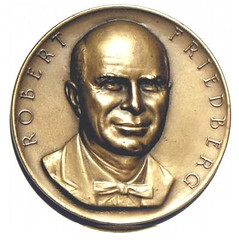 "That was a very nicely done piece with just a couple of minor inaccuracies not even worth bothering with. One major one was "in 1947 he was hired by Jacques Minkus to manage the coin department at Gimbels."
"That was a very nicely done piece with just a couple of minor inaccuracies not even worth bothering with. One major one was "in 1947 he was hired by Jacques Minkus to manage the coin department at Gimbels."
"He was not "hired." It was a business agreement. The department had been run by a partnership of Hans Schulman, Abe Kosoff, and Abner Kreisberg. It should come as no surprise to anyone that that did not work out. My father took it over and the deal was that rent was a flat 20% of sales, payable after the close of the month after Minkus got his remittance from the individual stores. Minkus was paying, we found out, about 10%. By the end of the 70's both the coin business and department store hours and return policies had changed enough that this was no longer tenable, and that is why we got out of the department stores."
Thanks for the background! Dave Lange agrees that the medals were left blank. -Editor
Dave writes:
"I want to make one minor correction to Pete Smith's article about Robert Friedberg. Pete suggested that the Coin & Currency Institute engraved the back of this medal to personalize it for the recipients. The medal indeed was left blank on its back, but that was done in the event that the recipients wanted to have it engraved themselves. The example in my collection is not engraved, and I gather that Pete's specimen is likewise blank.
"Issuing a medal to honor Robert Friedberg's life and work was only appropriate, as he had done so much to popularize medal collecting. The C&CI sponsored numerous medal issues in the late 1950s and throughout the 1960s. These typically covered popular topics that had broad appeal and would sell well, such as the statehoods of Alaska and Hawaii and the centennial of America's Civil War. Perhaps, the most notable line of C&CI-backed medals was the series of honorees in The Hall of Fame For Great Americans. The company even produced a rare album to house these. I'm attaching a double-page ad from the February 1965 issue of The Numismatist that features both the medals and the album."
To read the earlier E-Sylum article, see:
ROBERT FRIEDBERG (1912-1963)
(https://www.coinbooks.org/v25/esylum_v25n01a16.html)
NOTES FROM E-SYLUM READERS: JANUARY 9, 2022
Wegefarth's Gold and Silver Dollar Saloon
Dave Schenkman writes:
"I found the article on the Gold Dollar Saloon in Buffalo, NY interesting. On page 106 of my hard rubber token catalog is a token from the Silver Dollar Saloon, with Wegefarth's name on the reverse. Wegefarth also issued brass tokens, which are listed in Wright.
"I took a quick look at the 2015 article. The authors commented that the Gold Dollar Saloon and the Silver Dollar Saloon were competitors, but later in the article he say that Gus Wegefarth owned the Gold Dollar; Wegefarth obviously owned the Silver Dollar also, since his name is on the hard rubber token."
Thanks. Too bad we'll probably never know the fate of the displayed coins. -Editor
To read the earlier E-Sylum article, see:
GOLD DOLLAR SALOON OPEN ON NEW YEAR'S DAY
(https://www.coinbooks.org/v25/esylum_v25n01a08.html)
Other topics this week include Engraver Lorenzo Hatch, Public Debt of the American Revolution, and the Hydeman 1913 Nickel. -Editor
WAR OF 1812 IN AMERICAN AND BRITISH MEDALS
British Numismatic Society Secretary Peter Preston-Morley writes:
"Our Society's annual meeting at NYINC will take place in the Morgan Suite at the InterContinental New York Barclay, on E 48th Street, on Saturday January 15th, at 4 PM.
I'm very pleased to say that our speaker will be John Kraljevich, one of America's leading professional numismatists, who won't need any introduction to most of your readership. His talk is entitled We owe allegiance to no crown: the War of 1812 in American and British medals.
"The meeting will be chaired by Robert Hoge, Curator Emeritus at the American Numismatic Society. All are welcome, and you don't have to be a member of the Society to attend."
2022 NATIONAL MONEY SHOW EXHIBITS
I didn't have a chance to publish this ANA press release when it first came out last month, but for those looking forward to the year's coin shows, here's a preview of some great planned attractions at the 022 Colorado Springs National Money Show. -Editor
Historic gold coin will make rare public appearance, March 10-12
Described by the American Numismatic Association Money Museum as "one of the most coveted coins in the numismatic universe," the ANA's 1933 Indian Head $10 gold Eagle will be publicly exhibited for the first time in years at the 2022 National Money Show® in Colorado Springs, Colorado, March 10-12.
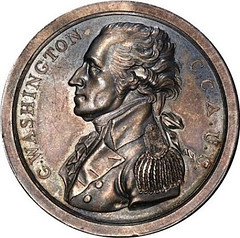 Show attendees will also see the first exhibition of examples of George Washington-related medals from the Historical Society of Pennsylvania and the first display from a recent, major donation of California Territorial gold coins.
Show attendees will also see the first exhibition of examples of George Washington-related medals from the Historical Society of Pennsylvania and the first display from a recent, major donation of California Territorial gold coins.
The show will be held at the world-famous Broadmoor resort in Colorado Springs.
PCGS RECLASSIFIES FUGIOS AS REGULAR U.S. ISSUES
The past never changes, but our knowledge and understanding of it often does. In this press release, PCGS announces its reclassification of the Fugio Cent as a regular U.S. issue. -Editor
The Fugio Cent has long been one of the most enjoyed early American collectibles, and now numismatists can count it as the earliest of all United States regular-issue coins.
Professional Coin Grading Service (www.PCGS.com) is announcing the groundbreaking reclassification after an exhaustive study carried out by a team of leading numismatic experts including John Dannreuther, Gordon Wrubel, Craig Sholley, Brian Greer, Chuck Link, Tony Terranova, Chris Victor-McCawley, David McCarthy, and Erik Goldstein.
VOCABULARY TERM: HALLMARKS AND HALLMARKING
Here's another entry from Dick Johnson's Encyclopedia of Coin and Medal Terminology. -Editor
Hallmarks and Hallmarking. A group of related symbols applied to silver and gold items indicating the maker, the date and the quality of its precious metal. From two to five symbols – applied by a punch, puncheon and called a mark – were stamped into existing silver and goldware. Hallmarking required some type of assaying and was first the mark of purity or fineness of the metal. The concept of hallmarking by an entity not the maker was that it guaranteed the purity of the precious metal by a third-party, the item did not have to be re-assayed at any later time. It thus aided in preventing fraud (of less pure metal being sold for higher purity).
HARVEY STACK AND STACK'S BOWERS GALLERIES
American Numismatic Biographies author Pete Smith submitted this article on the late Harvey Stack and the creation of Stack's Bowers Galleries. Thank you! -Editor
Harvey Gerald Stack (1928-2022)
Harvey Stack was the last of his generation with the family firm of Stack's. The numismatic and auction version of Stack's dates back to 1933. Joseph (1891-1974) and his younger brother Morton (1901-1967) reformed their father's brokerage house to service the rare coin market. The next generation included Joseph's children, Shirley (1904-1991), Benjamin (1925-1984) and Norman (1928-1992), and Morton's son Harvey. After the death of Norman in 1992, only Harvey and his son, Lawrence, remained with the Stack's company.
RESEARCHING THE NEW YORK NUMISMATIC SOCIETY
Recently American Numismatic Society Librarian David Hill and Joel Orosz authored an ANS Pocket Change article about a little known incarnation of the New York Numismatic Society which may well have been the first numismatic association in the United States. A key piece of information in their article came from a newspaper article pasted into a book produced by Charles Ira Bushnell which Joel purchased from John Lupia.
John had discovered this tidbit earlier and added it to the draft of a planned second volume of his book on American Numismatic Auctions. John has since expanded his research with additional references to the organization, and published it on his website. With permission we're publishing an excerpt here - see the developing research online via the link below.
Thank you! Great discoveries. It seems Bushnell was a member of the first numismatic society in the United States, which predated the Numismatic Society of Philadelphia and the American Numismatic Society (both founded in 1858). -Editor
This essay is dedicated to John W. and Regina Adams, Dave Bowers, Joel Orosz, and David Hill, and fond memory of the late Eric P. Newman.
What follows is part of an over all work on the history of collecting in America. It is interesting to note that there are two distinct personalities regarding collecting. First, is the collector of one degree or another, from the light collector to the hoarder. Second, the opposite personality that can't wait to dispose of things. The curious thing is they frequently marry.
A BEVY OF BECHTLERS
A blog article by researcher Ron Guth of the the Numismatic Detective Agency examines a great group of Bechtler gold in the Heritage FUN sale. Here's an excerpt - see the complete article online. -Editor
Few Americans know that the first Gold Rush in the United States began in North Carolina -- not California -- and that the first major discovery of gold in America was in 1799, not 1848. The second Gold Rush took place on Cherokee lands in Georgia in 1829. Difficulties in transporting southern gold the long distance to the U.S. Mint at Philadelphia gave rise to private mints beginning in 1830 and eventually resulted in the establishment of branch mints at Charlotte, North Carolina and Dahlonega, Georgia in 1838.
HERITAGE FUN CURRENCY AUCTION ERRORS
I've been wanting to show these great error notes for a few weeks now, and they're coming up in the Heritage January 12-14 FUN Currency Auction. In the December 23, 2021 Heritage Currency News email newsletter, Frank Clark published a group of highlights. -Editor
We are proud to present 59 different lots of error notes at our upcoming FUN Auction. Their estimates range from $1,500 and up to $35,000. In this article, we would like to discuss a few of the most distinctive errors.
STEPHEN ALBUM RARE COINS AUCTION 42
Here's the press release for Stephen Album Rare Coins upcoming Auction 42. Great material! -Editor
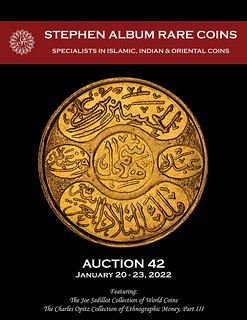 Stephen Album Rare Coins will hold its Auction 42 on January 20-23, 2022 at its offices in Santa Rosa,
California. The Auction is made up of 3,200 lots of Ancient, Islamic, Chinese, Indian, and General World
Coins.
Stephen Album Rare Coins will hold its Auction 42 on January 20-23, 2022 at its offices in Santa Rosa,
California. The Auction is made up of 3,200 lots of Ancient, Islamic, Chinese, Indian, and General World
Coins.
Featured in the sale is the Joe Sedillot Collection (Part I) which includes a wide array of type coins from numerous countries. A large proportion of the coins in the collection are in choice condition and were selected for encapsulation in PCGS holders. Additional selections from the collection will be offered in subsequent auctions in Spring 2022. Also featured in this sale is The Charles Opitz Collection of Primitive Money, Part III.
One notable change the firm has made beginning with this auction is that group/bulk lots are now consolidated at the end of the sale for more convenient locating (see lots 2752 to 3200).
NUMISMATIC AUCTIONS LLC SALE 66
Steve Davis of Numismatic Auctions LLC passed along this announcement of his January 2022 sale #66. Look forward to more details in the upcoming weeks. -Editor
Absentee Bidding Closes January 31, 2022 - Internet Bidding Closes February 7-11, 2022
Featuring the Robert H. Colegrove and Grand Blanc Collections along with many other fine consignments!
THE BOOK BAZARRE
STACK'S BOWERS TO SELL SYD MARTIN COLLECTION
In a press release this week, Stack's Bowers Galleries announced their planned sale of the Syd Martin Collection. Wow! We'll look forward to the catalog(s)! -Editor
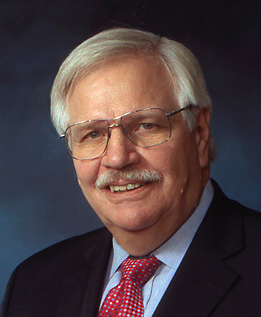 For three decades, Sydney F. Martin of Doylestown, Pennsylvania and Amelia Island, Florida
was a preeminent figure in American numismatics. He served as president of the American Numismatic Society and
was the author of standard references on no fewer than four early American numismatic specialties. Mr. Martin was
a graduate of the Massachusetts Institute of Technology and founder of The Sytex Group, which provided services
to the defense and intelligence communities before its acquisition by Lockheed Martin in 2005.
For three decades, Sydney F. Martin of Doylestown, Pennsylvania and Amelia Island, Florida
was a preeminent figure in American numismatics. He served as president of the American Numismatic Society and
was the author of standard references on no fewer than four early American numismatic specialties. Mr. Martin was
a graduate of the Massachusetts Institute of Technology and founder of The Sytex Group, which provided services
to the defense and intelligence communities before its acquisition by Lockheed Martin in 2005.
Stack's Bowers Galleries of Costa Mesa, California has been selected to sell Martin's many remarkable numismatic collections at public auction over a several year span, beginning in 2022. Stack's Bowers Galleries has sold most of the finest collections of pre-Federal coins presented at auction over the last 50 years. Many of Martin's most prized specimens will be offered at events in conjunction with the Baltimore Whitman Expos, the American Numismatic Association's World's Fair of Money, and the November conventions of the Colonial Coin Collectors Club.
NUMISMATIC NUGGETS: JANUARY 9, 2022
Here's a selection of interesting or unusual items I came across in the marketplace this week. Tell us what you think of some of these. -Editor
Medal depicting George Washington receiving a peace pipe from a Native American chief. U.S. Seal verso. Large version, engraved, not cast, with what looks like a lion seal at the hasp, riveted edge. Includes chain. 6 5/8" x 4 7/8", very good condition. 8.98 ozt.
From Thomaston Place Auction Galleries in Maine. The lot description says nothing about authenticity. Did we see this one before? -Editor
To read the complete lot description, see:
RARE COIN SILVER INDIAN PEACE MEDAL 1792
(https://live.thomastonauction.com/lots/view/1-58TGF7/rare-coin-silver-indian-peace-medal-1792)
Other topics this week include the Montefiore Hebrew Prize Medal, and World Prison Tokens and Scrip. -Editor
CELTIC GOLD COINS DISCOVERED IN BRANDENBURG
Arthur Shippee passed along this story about a find of Celtic gold coins from Brandenburg. Thanks - I was unfamiliar with the smooth rainbow cups type. Found via The Explorator newsletter. To subscribe to Explorator, send a blank email message to: explorator+subscribe@groups.io. -Editor
Together with the state archaeologist Prof Dr Franz Schopper, the numismatist Marjanko Pilekic and the finder and volunteer archaeologist Wolfgang Herkt, the Minister for Culture Dr Manja Schu¨le presented the largest hoard of Celtic gold coins found in the state of Brandenburg on 13 December 2021 in Potsdam.
RUNZE COLLECTION HAMMERED ENGLISH PENNIES
The King Offa penny caught my eye in this blog article by Stack's Bowers Numismatist for World and Ancient Coins Nicholas Fritz. My good friend Tom Fort studied Offa's coinage, and sported a great OFFA REX license plate. -Editor
Medieval coinage from the fall of Rome through the beginning of the modern period in 1600, excepting Byzantine coinage, has always been understudied and undercollected. This span of over 1,000 years includes diverse hammered and cast issues from Europe, the Near East, China, and India. Despite this, British hammered coinage from medieval times has always attracted attention and scholarship.
A CORRECTION TO TREASURE (RHODE) ISLAND
On December 18, 2021 Oliver Hoover published an ANS Pocket Change blog article with a correction to his earlier post regarding Jim Bailey's theories about Islamic coins found in North America. Here's a lengthy excerpt - see the complete article online. -Editor
On April 9, 2021, Pocket Change hosted a post of mine that took issue with the popularization of a theory originally published by Jim Bailey in the Colonial Newsletter in 2017. In Bailey's article, it was argued that silver khamsiya coins of Qasimid Yemen (Fig. 1) found (increasingly, it seems) in North America—particularly in Connecticut, Maine, Massachusetts, and Rhode Island—are directly connected to the English pirate Henry Every and his crew after their plunder of the Mughal treasure ship Ganj-i-Sawai in 1695.
QUEEN'S PLATINUM JUBILEE COINS UNVEILED
David Pickup passed along this article about the Royal Mint's new coins commemorating Queen Elizabeth II's platinum jubilee. Thanks! -Editor
A commemorative coin showing the Queen on horseback has been unveiled by the Royal Mint ahead of Her Majesty's Platinum Jubilee.
The coin, made at the mint in Llantrisant, south Wales, is the first collectable UK 50p to celebrate a royal event and was designed by artist John Bergdahl.
BANK OF CANADA MUSEUM ACQUIRES 1911 DOLLAR
The Bank of Canada Museum has acquired a centerpiece: a 1911 silver dollar. -Editor
After being the apple of many a coin collector's eye, The Emperor
has finally made its way into the Bank of Canada Museum's permanent collection.
The 1911 silver dollar had been in private hands for more than 60 years, but was recently acquired by the museum from a Canadian collector and will now have a permanent home in the National Currency Collection at the Bank Street heritage centre.
Unlike most coins that were mass produced, the 1911 silver dollar was never put into circulation, and only three trial strikes of the planned coin — or tests — were ever created: one in lead and two in silver.
VERNON MEDAL INSPIRES HISTORIAN'S BOOK
Gerry Tebben writes:
"I love how numismatics can lead down a rabbit hole. A book review in Saturday's Wall Street Journal recounts how author Robert Gaudi's chance encounter with a 1741 medal in a Georgetown flea market led to his researching the life of Admiral Edward Vernon. Gaudi didn't buy the medal, but he did write a book about Vernon, the wonderfully named "The War of Jenkins' Ear."
"The review is illustrated with a massive (6.5 inches in diameter) photo of a VERNON CONQUERED CARTAGENA medal. (Robert Jenkins, by the way, was a suspected smuggler who, the review helpfully explains, "lost an ear while undergoing interrogation.")"
Thanks - here's an excerpt from the article. It's always nice to see numismatics reflected in the mainstream media, even when it's just in passing. -Editor
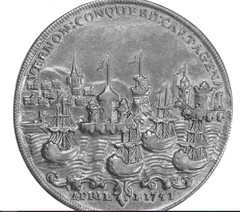 Browsing Georgetown Flea Market in Washington, D.C., writer Robert Gaudi chanced upon an old medal that piqued his curiosity. Keen to clinch a deal, the stall-holder was quick to emphasize that the tarnished item had
Browsing Georgetown Flea Market in Washington, D.C., writer Robert Gaudi chanced upon an old medal that piqued his curiosity. Keen to clinch a deal, the stall-holder was quick to emphasize that the tarnished item had some age on it,
a sales pitch that Mr. Gaudi soon discovered to be something of an understatement. An online search revealed the medal to be one among many variants struck to commemorate Adm. Edward Vernon, the hero of a largely forgotten colonial war waged between Britain and Spain from 1739 to 1742.
Although Mr. Gaudi declined to buy the medal, the discovery inspired his lively, sprawling and sometimes irreverent book about the conflict in which Vernon won fame, The War of Jenkins' Ear.
That curious title was only coined long after the last veteran was dead: British historian Thomas Carlyle first suggested the term in a footnote to his 1858 biography of Frederick the Great of Prussia, and the name stuck.
DUKE OF WELLINGTON AFGHANISTAN GOLD MEDALS
Stack's Bowers Galleries will sell a set of four Specimen gold medals for the 1842-1843 Afghanistan Campaigns presented to the Duke of Wellington. Beautiful medals. Here's the lot description. -Editor
Magnificent Set of Four Specimens Presented to the Duke of Wellington
1842-43 Medals for Afghanistan Campaign Gold Strike Medals.
A unique object, created for and presented to Arthur Wellesley, the Duke of Wellington. Four gold medals, each housed in a gold-rimmed glazed case and contained in a custom made fine silk and leather lined leather case, tooled in blind and gilt, 115.5 x 115.5 mm. The case is hinged to allow each of the medals to be seen from obverse and reverse, and the cased and glazed medals are each easily removed. Each medal is struck with a matching fine frosted/matte finish in rich yellow gold. The medals, their glass enclosures, and the case, are all in flawless condition, essentially as issued. The medals included are:
CHARLESTON SLAVE BADGE TOP FIND OF 2021
A slave badge unearthed by a team of researchers and students at the College of Charleston this spring has been named one of the top discoveries of 2021 by Archaeology Magazine. -Editor
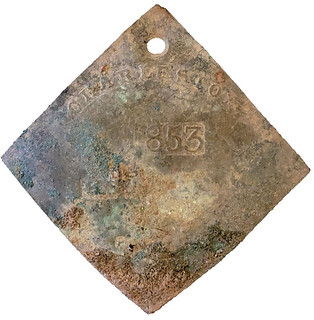 A tag worn by an enslaved person who was hired out by his or her enslaver has been discovered in the remnants of a mid-nineteenth-century kitchen on the campus of the College of Charleston. Such tags, which were issued from the late eighteenth century until 1865, bore registration numbers and identified enslaved people by their trades, such as carpenter, blacksmith, fisherman, or domestic servant. This example, badge number 731, dates to 1853 and is stamped with the word
A tag worn by an enslaved person who was hired out by his or her enslaver has been discovered in the remnants of a mid-nineteenth-century kitchen on the campus of the College of Charleston. Such tags, which were issued from the late eighteenth century until 1865, bore registration numbers and identified enslaved people by their trades, such as carpenter, blacksmith, fisherman, or domestic servant. This example, badge number 731, dates to 1853 and is stamped with the word servant.
THE BOOK BAZARRE
RMS CARPATHIA MEDAL
Louise Boling published a nice article on the RMS Carpathia medal in the January 8, 2022 issue of MPC Gram, the email newsletter for collectors of Military Payment Certificates and other military numismatica. With permission, we're republishing it here. To subscribe, enter your email address here:
Subscribe to the MPC Gram today!
.
Thank you!
-Editor
On December 29th, the Jeopardy Final Jeopardy clue was In the morning of April 15, 1912 officer Charles Lightoller became the last of about 700 people to board this ship.
Hmm. 1912 – not the Lusitania. That happened in 1915. The Titanic was 1912 – but people were not boarding her, they were desperately trying to get off her. The answer: the RMS Carpathia.
POYAIS: GREGOR MACGREGOR'S FAKE COUNTRY
Pablo Hoffman passed along this article from The Hustle about a scam that gave rise to some Central American paper money rarities. Thanks! Bizarre story. Here's an excerpt, but see the complete article online. -Editor
On March 20, 1823, after 2 grueling months sailing across the Atlantic Ocean, passengers gathered on the deck of the Kennersley Castle for the first glimpse of their new lives in the country of Poyais.
The view was immaculate: Sun glistening in the shallow waters of a blue lagoon. Mahogany trees drooping over sandy beaches.
James Hastie, who was moving to Poyais with his wife and 2 children, thought the country had a very beautiful appearance from the sea.
PENNY PILE PRECIPITATES PROSECUTION
Leon Saryan sent in this update to last March's story about a Georgia company's pile of revenge pennies. -Editor
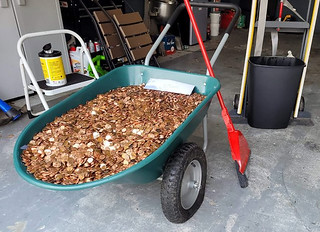 When Andreas Flaten didn't receive his final paycheck from a former employer last January, he complained about it, calling up the US Department of Labor to lodge an accusation of wage theft. That employer responded by leaving more than 91,000 pennies on his driveway in Fayetteville, Georgia.
When Andreas Flaten didn't receive his final paycheck from a former employer last January, he complained about it, calling up the US Department of Labor to lodge an accusation of wage theft. That employer responded by leaving more than 91,000 pennies on his driveway in Fayetteville, Georgia.
Now the US government is suing that company, arguing the act constituted illegal retaliation.
In a complaint filed with a federal court in Georgia, the Department of Labor accuses A OK Walker Autoworks and its owner, Miles Walker, of more than just pettiness.
LOOSE CHANGE: JANUARY 9, 2022
Here are some additional items in the media this week that may be of interest. -Editor
In the you-just-can't-make-this-stuff-up department, a Mayor in the Philippines fires money at voters with gun. -Editor
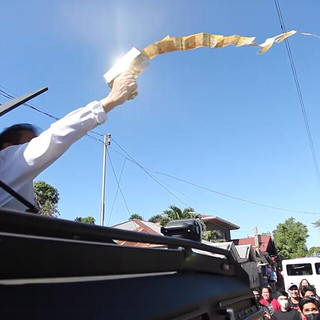 The mayor of the city of Narvacan with a population of less than 50,000 in the Philippines, businessman Luis
The mayor of the city of Narvacan with a population of less than 50,000 in the Philippines, businessman Luis Chavit
Singson, became the object of criticism by Filipino Internet users after publishing a video in which he distributes money to his voters with the help of a golden gun made especially for this purpose.
A 43-second video published on Facebook, in which Singson shoots banknotes in denominations of 100 and 500 pesos (PLN 8-40) with a pistol, has been viewed nearly 3 million times. You can see the politician walking among the people, raising his hand and pressing the trigger of the gun, and money is pouring out of it. In other fragments of the video Singson throws banknotes in the same way from a stationary car, and people shove through trying to grab them.
Many Internet users praised the politician for his generosity in the comments, but there were also those who accused him of humiliating voters. I have the impression that he was making fun of poor people. Why didn't he put the money in the envelopes and hand them out one by one?
One of the users of the social platform asked.
To read the complete article, see:
Philippines. Mayor criticized for shooting gold-gun banknotes at voters
(https://sparkchronicles.com/philippines-mayor-criticized-for-shooting-gold-gun-banknotes-at-voters/)
Other topics this week include the U.S. Government's Gold and Silver Promises, How to Read Critically, and the fabled cache of Civil War gold in Pennsylvania. -Editor
FEATURED WEB SITE: INTERNATIONAL TOKEN WEB CONFERENCE
This week's Featured Web Site is the International Token Web Conference

